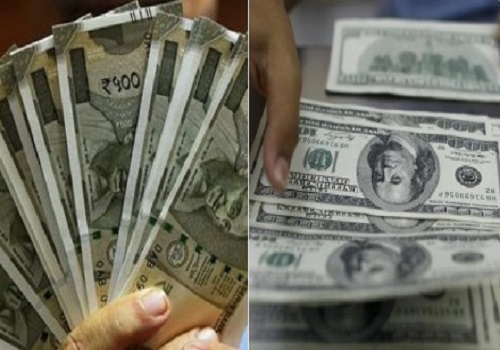Zinc trading range for the day is 263.7-272.9 - Kedia Advisory

Gold
Gold prices settled lower by 0.53% at 71,743 as the U.S. dollar strengthened ahead of a key U.S. inflation reading, which is expected to provide more clarity on the Federal Reserve's likely rate cut in September. Fed Chair Jerome Powell emphasized that while the time has come to adjust policy, the timing and pace of rate cuts will depend on incoming data and the evolving economic outlook. According to the CME FedWatch tool, traders are currently pricing in a 71.5% chance of a 25-basis-point rate cut in September, with a 28.5% probability of a larger 50-basis-point cut. In China, gold demand is expected to improve in the coming months as consumers adjust to higher prices, driven by economic uncertainty and concerns about currency weakness. China's net gold imports via Hong Kong rose by 17% in July compared to June, reflecting an increase in investment demand. However, in major Asian hubs, the recent rally in gold prices has stifled demand, leading dealers to offer deeper discounts to attract buyers. In India, gold demand is set to improve in the second half of 2024 due to a correction in local prices following a reduction in import taxes, coupled with the support of good monsoon rains. From a technical perspective, the gold market is under long liquidation, with open interest dropping by 2.92% to settle at 16,569 as prices fell by 379 rupees. Gold is currently finding support at 71,475, with potential downside to 71,215. On the upside, resistance is expected at 72,035, with a move above this level potentially testing 72,335.
Trading Ideas:
* Gold trading range for the day is 71215-72335.
* Gold fell as investors awaited a key U.S. inflation reading for clarity on a likely September rate cut by Fed.
* Fed Powell stated the time has come for policy adjustment, but the timing and pace of rate cuts depend on incoming data.
* Gold demand in China is expected to improve in coming months due to economic uncertainty.
Silver
Silver prices fell sharply by 1.96% to settle at 83,977 as the U.S. dollar gained strength, with the dollar index hovering above 101. This recovery in the dollar followed its earlier dip to a 13-month low, as markets continued to evaluate the monetary policy outlook of major central banks. Investors are positioning for upcoming rate cuts by the Federal Reserve, particularly after Fed Chair Jerome Powell's dovish comments at the Jackson Hole symposium. Swap prices currently indicate an expectation of approximately 100 basis points in rate cuts by the Fed over its three remaining meetings this year. However, recent signs of resilience in the U.S. economy, such as the sharp rebound in durable goods orders, have cast some doubt on the extent of the rate cuts in the forthcoming loosening cycle. On the global front, India's silver imports are set to nearly double this year, driven by increased demand from the solar panel and electronics sectors, as well as growing investor interest in silver as a potentially better-performing asset than gold. In the first half of 2024, India's silver imports surged to 4,554 metric tons, a significant jump from 560 tons in the same period last year. This increase is partly due to industrial buyers stockpiling silver to hedge against rising prices after inventories were depleted in 2023. Technically, the silver market is experiencing long liquidation, as evidenced by a significant 44.53% drop in open interest to settle at 10,983 contracts while prices declined by 1,681 rupees. Silver is currently finding support at 83,280, with further downside potential to 82,580. On the upside, resistance is likely at 85,050, with a move above this level potentially testing 86,120.
Trading Ideas:
* Silver trading range for the day is 82580-86120.
* Silver dropped as dollar index hovers above 101
* Markets assess monetary policy outlook for major central banks
* Investors anticipate incoming rate cuts by the Federal Reserve
Crudeoil
Crude oil prices settled lower by -1.02% at 6,288, driven by concerns over weakening global demand and ongoing economic uncertainty. Major banks have revised their price forecasts downward, reflecting slowdowns in key markets such as China, where economic challenges and a shift toward electric vehicles are reducing fuel consumption. In Europe, diesel demand is expected to fall below pre-pandemic levels due to weak manufacturing activity and changes in the car fleet, adding to the bearish sentiment in the market. These negative factors are overshadowing the gains previously driven by geopolitical risks and supply threats. In Libya, the Sirte Oil Company announced a partial reduction in production, adding to the country's fluctuating oil output, which stood at approximately 1.18 million barrels per day in July, according to OPEC. In the U.S., crude oil inventories saw a decrease of 0.846 million barrels for the week ending August 23, 2024, falling short of the expected 3 million barrel reduction. Additionally, stocks at the Cushing, Oklahoma delivery hub dropped by 668 thousand barrels, following a 560 thousand decline the previous week. Gasoline inventories experienced a significant drop of 2.203 million barrels, exceeding the anticipated 1.5 million barrel decline, while distillate fuel inventories rose slightly by 0.275 million barrels, contrary to the forecasted drop of 0.55 million barrels. Technically, the crude oil market is undergoing long liquidation, with open interest decreasing by -1.48% to settle at 6,998 contracts. Prices are currently supported at 6,212, and a break below this level could lead to a test of 6,135. On the upside, resistance is likely at 6,367, with a potential move towards 6,445.
Trading Ideas:
* Crudeoil trading range for the day is 6135-6445.
* Crude oil dropped on profit booking after prices rose on supply concerns
* Crude oil inventories at Cushing have fallen to six-month lows.
* U.S. crude inventories were expected to have fallen by about 3 million barrels last week
Naturalgas
Natural gas prices surged by 2.64% to settle at 178.8, driven by increased demand from power generators who opted to burn more gas and less coal due to relatively low gas prices in recent weeks. This upward movement occurred despite forecasts for milder weather over the next two weeks and the temporary shutdown of the Freeport LNG export plant in Texas. The shutdown was due to the unexpected activation of a fire suppression system during routine maintenance, which temporarily reduced the amount of gas flowing to the plant for LNG export. Even with less hot weather on the horizon, power generators have been burning more gas to meet electricity demands. The U.S EIA reported that natural gas storage levels were about 12% above the seasonal average, although weekly builds have been smaller than normal in 13 of the past 14 weeks. Gas production in the Lower 48 U.S. states averaged 102.4 billion cubic feet per day (bcfd) in August, down from 103.4 bcfd in July. Despite the hotter-than-normal weather, the arrival of autumn is expected to bring a gradual decline in temperatures. Looking ahead, gas demand in the Lower 48 states, including exports, is forecast to decrease from 104.6 bcfd this week to 101.2 bcfd next week. Meanwhile, gas flows to the seven major U.S. LNG export plants increased to 12.9 bcfd in August, up from 11.9 bcfd in July. From a technical standpoint, the natural gas market is experiencing short covering, as evidenced by a 5.88% drop in open interest, settling at 49,521 contracts. Natural gas is currently supported at 172.9, with potential downside to 167.1. On the upside, resistance is expected at 182.4, with a move above this level potentially testing 186.1.
Trading Ideas:
* Naturalgas trading range for the day is 167.1-186.1.
* Natural gas gains as relatively low gas prices in recent weeks prompted power generators to burn more gas.
* Despite 12% more gas in storage than usual, weekly builds have been smaller than normal in 13 of the past 14 weeks.
* LSEG reported a drop in gas output in Lower 48 U.S. states to an average of 102.4 bcfd in August.
Copper
Copper prices fell by -1.47% to settle at 807.05, weighed down by weak economic data from major economies and ongoing concerns about demand, particularly in China. Despite a slight improvement in physical copper demand in China, the market remains apprehensive due to weak factory output and low confidence in the struggling property sector. The market sentiment has also been impacted by an unexpected surge in Chinese copper exports, which has led to a significant sell-off by funds, driving prices down by 16% from the record highs seen in May. In June, China exported an unprecedented 158,000 metric tons of refined copper, and first-half exports reached 302,000 tons, surpassing any full calendar year since 2019. However, this export burst appears to be tapering off, with shipments falling to 70,000 tons in July. ShFE stocks have been declining since the beginning of July, and at 262,206 tons, they are now 75,000 tons below the June peak. The global refined copper market showed a surplus of 95,000 metric tons in June, up from a 63,000 metric tons surplus in May, according to the International Copper Study Group (ICSG). For the first half of the year, the market recorded a surplus of 488,000 metric tons, compared to 115,000 metric tons during the same period last year. Technically, the copper market is under fresh selling pressure, with open interest increasing by 7.34% to settle at 10,661 contracts. The price is currently supported at 803.5, and a break below this level could lead to a test of 799.9. On the upside, resistance is anticipated at 813.7, with a potential move toward 820.3.
Trading Ideas:
* Copper trading range for the day is 799.9-820.3.
* Copper prices dropped due to weak economic data and demand concerns.
* Physical copper demand in China slightly improved, but concerns remained due to weak factory output.
* ShFE stocks have been decreasing since July, currently 75,000 tons below the June peak, with 262,206 tons currently in the stock.
Zinc
Zinc prices declined by 1.47% to settle at 267.35, driven by concerns over weak demand from China and a rebound in the U.S. dollar, which led to selloffs by funds and producers. The ongoing weakness in China's factory output and low confidence in the struggling property sector have raised doubts about the sustainability of zinc's recent upward momentum. The recovery of the U.S. dollar from its one-year low added further pressure on metals prices as traders awaited key economic data that could influence the Federal Reserve's upcoming September policy meeting. Despite these bearish factors, zinc prices received some support from an agreement among 14 major Chinese zinc smelters to reduce production in response to falling treatment charges (TCs), which have significantly eroded profitability. These TCs have dropped to historical lows due to a tight supply of zinc concentrates. China's zinc output has already been curtailed in July and August, with official data showing a 9.2% decline in July, bringing production to its lowest level in a year at 536,000 tons. The ongoing production cuts are expected to reduce output by 30,000 to 40,000 tons each month from September to December, accounting for 3-4% of the total annual zinc ingot output. On the technical side, the zinc market is experiencing long liquidation, as evidenced by an 11.69% drop in open interest, settling at 2,137 contracts. Zinc prices are currently supported at 265.5, with further downside potential to 263.7. On the upside, resistance is expected at 270.1, with a move above this level potentially testing 272.9.
Trading Ideas:
* Zinc trading range for the day is 263.7-272.9.
* Zinc dropped as concerns over demand from China and a rebound in the U.S. dollar triggered selloffs
* China's zinc output fell for a second consecutive month in July, down by 9.2% from June.
* 14 major Chinese zinc smelters agreed to cut production due to falling treatment charges, reducing profits.
Aluminium
Aluminium prices fell by -2.21% to settle at 228.4, driven by a combination of factors including a supply surplus and concerns over global demand. According to the World Bureau of Metal Statistics, global primary aluminum production in June was 5.9031 million tons, while consumption was 5.8059 million tons, resulting in a supply surplus of 97,200 tons. For the first half of the year, the global market experienced a surplus of nearly 720,000 tons, with production totaling approximately 35.45 million tons and consumption around 34.73 million tons. Despite the downward pressure on prices, strong demand for alumina and a tight supply of bauxite have provided some support, pushing prices to a more than six-week high on the LME earlier. The LME cash aluminum discount to the three-month contract has narrowed to $17.08 per ton, its smallest since May 1, reflecting tightening nearby supply. LME aluminum inventories have also dropped by 22% over the past three months, reaching 877,950 tons, the lowest since early May. China's aluminum market dynamics further influenced prices, with July's aluminum output rising 6% year-on-year to 3.68 million metric tons, marking the highest monthly output since 2002. This increase is largely attributed to new projects in Inner Mongolia and consistent production in other key regions. Global primary aluminum output in July also rose by 2.4% year-on-year, according to the International Aluminium Institute. Technically, the market is under fresh selling pressure, with open interest increasing by 6.92% to settle at 3,323 contracts. The price is currently supported at 226.8, with a break below this level potentially leading to a test of 225. On the upside, resistance is anticipated at 231.7, with a potential move toward 234.8.
Trading Ideas:
* Aluminium trading range for the day is 225-234.8.
* Aluminium dropped as global primary aluminum market has surplus of 97,200 tons in Jun
* LME aluminium inventory dropped 22% in three months to 877,950 tons, the lowest since May 8.
* China exported 146,708 tons of alumina last month, with 92.5% flowing into Russia.
Cottoncandy
Cottoncandy prices rose by 0.57% yesterday, closing at Rs.58,020, driven by concerns over reduced acreage in the current kharif cropping season. The area under cotton cultivation has decreased by approximately 9% to 110.49 lakh hectares (lh) compared to 121.24 lh last year, with the Cotton Association of India (CAI) projecting an even lower total acreage of around 113 lh for this year, down from 127 lh in the previous year. This reduction is largely attributed to farmers shifting to other crops due to lower yields and high production costs. The CAI has also highlighted a tighter cotton balance sheet for the upcoming season, driven by higher-than-expected exports to Bangladesh, which have surged from 15 lakh bales to 28 lakh bales. India’s cotton production and consumption for 2023-24 are both estimated at around 325 lakh bales. However, the gap created by higher exports and imports will tighten the availability of cotton stocks, with an estimated 70 lakh bales available for consumption up to September 30. If the new crop is delayed, this could further strain supply for mills. Globally, the 2024/25 cotton balance sheet shows reductions across production, consumption, and stock levels, with world production down by 2.6 million bales due to lower output in the United States and India. Consumption has also decreased, particularly in China, leading to a reduction in world ending stocks to 77.6 million bales. Technically, the Cottoncandy market is experiencing fresh buying, with open interest increasing by 0.57%. The price finds immediate support at Rs.57,940, with further support at Rs.57,870. On the upside, resistance is likely at Rs.58,090, with potential testing of Rs.58,170 if the upward momentum continues.
Trading Ideas:
* Cottoncandy trading range for the day is 57650-57850.
* Cotton dropped on profit booking after prices gaied as Cotton acreage trails by 9% at 110 lh
* CAI predicts acreage to be around 113 lh this year, up from 127 lh in the previous year.
* Global cotton production cut by 2.6 million bales; lower in US, India.
* In the global 2024/25 cotton balance sheet, beginning stocks, production and consumption are increased.
Turmeric
Turmeric prices experienced a sharp decline of 5.58% to settle at 12,856, primarily due to limited demand as buyers remain cautious about making purchases. The export market is also facing challenges, particularly with anticipated volatility in Bangladesh, further complicating export opportunities. Additionally, dry weather conditions in Indonesia have accelerated turmeric harvesting, which is currently at its peak. The combination of increased acreage and reduced export demand is exerting downward pressure on prices, with many farmers selling their turmeric in the wet stage itself, reducing production volumes. News of increased sowing is also contributing to the bearish sentiment in the market. Reports indicate that turmeric sowing on the Erode line has doubled compared to last year, while Maharashtra, Telangana, and Andhra Pradesh have seen a 30-35% increase in sowing. This surge in acreage could potentially lead to an oversupply situation, further driving prices down. Despite these factors, the downside is somewhat limited as farmers are holding back stocks in anticipation of a potential price rise. Last year’s unfavorable weather conditions and low sowing led to a reduced production estimate of 45-50 lakh bags for 2024. Even with the increased sowing this year, the upcoming turmeric crop is expected to be around 70-75 lakh bags, with no outstanding stock remaining, which could lead to a tighter supply in 2025. From a technical perspective, the turmeric market is undergoing long liquidation, with open interest dropping by 5.38% to settle at 16,435 contracts. Turmeric is currently supported at 12,548, with potential downside to 12,240. On the upside, resistance is expected at 13,416, with a move above this level potentially testing 13,976.
Trading Ideas:
* Turmeric trading range for the day is 12240-13976.
* Turmeric dropped as demand remains limited, as buyers are reluctant to make purchases.
* Pressure also seen amid news of increased sowing.
* In Indonesia, dry weather has accelerated harvesting, which is currently at peak levels.
* In Nizamabad, a major spot market, the price ended at 14511.4 Rupees dropped by 0 percent.
Jeera
Jeera prices settled slightly lower by -0.06% at 25,420, pressured by expectations of higher production in the current season. Despite this, the downside was limited due to robust domestic and export demand, coupled with tight global supplies. Farmers have been holding back their stocks, anticipating better prices, which has also supported the market. The current season is expected to see a 30% increase in jeera production, reaching 8.5-9 lakh tonnes, driven by a substantial rise in cultivation area. In Gujarat, the sowing area has increased by 104%, while in Rajasthan, it has risen by 16%. Globally, jeera production has also seen significant growth, particularly in China, where output has more than doubled to 55-60 thousand tons. Other countries like Syria, Turkey, and Afghanistan have also ramped up production, further adding to the supply pressure. As these new supplies enter the market, prices are likely to face additional downward pressure. However, India's jeera exports have been strong, rising by 46.56% during April-June 2024 compared to the same period last year. In June 2024 alone, exports were up by 60.13% year-on-year, despite a monthly decline from May 2024. In the spot market at Unjha, prices dropped slightly by -0.08% to 25,359.6 Rupees. Technically, the market is under long liquidation, with open interest decreasing by -2.8% to settle at 2,397 contracts. Jeera is currently finding support at 25,310, with a break below this level potentially leading to a test of 25,190. On the upside, resistance is likely at 25,560, with further gains possibly pushing prices towards 25,690.
Trading Ideas:
* Jeera trading range for the day is 25190-25690.
* Jeera settled flat as the expectation of higher production weighed on the prices.
* China's cumin output soared to over 55-60 thousand tons from the previous 28-30 thousand tons.
* Turkey anticipates producing 12-15 thousand tons, while Afghanistan's output could double.
* In Unjha, a major spot market, the price ended at 25359.6 Rupees dropped by -0.08 percent.
Views express by all participants are for information & academic purpose only. Kindly read disclaimer before referring below views.


















